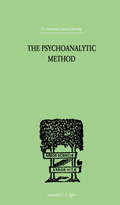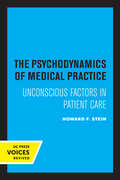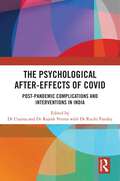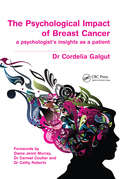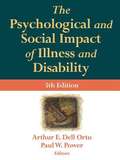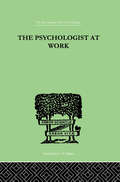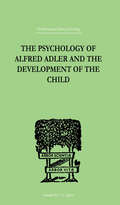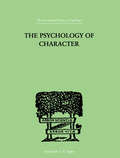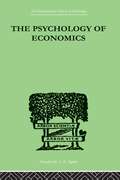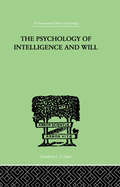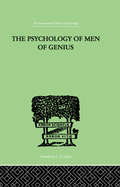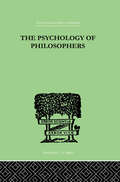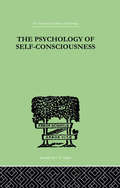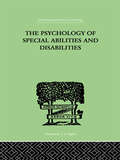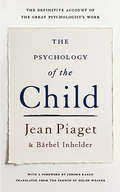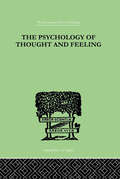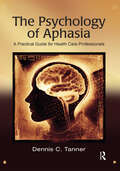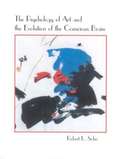- Table View
- List View
The Psychoanalytic Method
by Pfister, OskarFirst Published in 1999. Routledge is an imprint of Taylor & Francis, an informa company.
The Psychodynamics of Medical Practice: Unconscious Factors in Patient Care
by Howard F. SteinThis title is part of UC Press's Voices Revived program, which commemorates University of California Press’s mission to seek out and cultivate the brightest minds and give them voice, reach, and impact. Drawing on a backlist dating to 1893, Voices Revived makes high-quality, peer-reviewed scholarship accessible once again using print-on-demand technology. This title was originally published in 1985.
The Psychological After-Effects of Covid: Post-Pandemic Complications and Interventions in India
by Rajesh Verma Dr Uzaina Ruchi PandeyThis comprehensive resource provides a one-stop information repository, exploring all psychological aspects of Covid-19. It documents the after-effects of the Covid pandemic, and how it transformed India as a society and its citizens as individuals. The book covers the psycho-social impact on society and individuals and our collective behaviour, as well as coping strategies and interventions and how lessons learned will help in preparedness for the future.Including case studies and the latest research, this book examines how psycho-social paradigms changed as a result of the pandemic, and left their watermark on the human psyche. It also explores the coping strategies adopted to deal with this common aggressor and how the techniques varied in accordance with social, cultural and geographical factors. The final chapters offer new insights for the future, highlighting the psychological infrastructure required, the type of preparedness and handling strategies necessary to mitigate the impact of any future biogenic pandemics.Combining theory and practical application, it will be valuable reading for academics and researchers as well as practising psychologists, clinical psychologists, and law-makers who are concerned with mental health.
The Psychological Impact of Breast Cancer: A Psychologist's Insight as a Patient
by Cordelia Galgut'It's rare to find a professional in the field of health care who understands the psychology of such a frightening experience and who has also been through it herself. Cordelia's book will ring true to every woman who has experienced breast cancer and will, I hope, offer insight to doctors and nurses.' - From the foreword by Jenni Murray OBE What is it like to experience breast cancer? This book presents rare and valuable insights into the impact of diagnosis, treatment and prognosis from a woman who has experienced breast cancer as both patient and as health professional. It informs and educates readers about the psychological realities of living with breast cancer, of treatments such as surgery and radiotherapy, and the impact of social and historical attitudes to the breast and breast cancer on a woman's experience of the disease. The conflicts Cordelia Galgut experienced between conventional wisdom and her own first-hand experience are explored vividly and reflectively. The Psychological Impact of Breast Cancer is vital reading for medical and mental health professionals and trainees working with breast cancer patients, and for those who are affected by or have an interest in the condition. 'The aim of this book, and the way forward, is to understand that we must all be more sensitive to the feelings of patients and to the suffering, uncertainty and sense of vulnerability that this disease imposes upon them.' - Dr Carmel Coulter in her Foreword 'This book has helped me understand the complexities that my patients present and has turned me into a better doctor. It has eased my way along the road that I now travel as a cancer survivor.' - Dr Cathy Roberts in her Foreword ]
The Psychological Significance of the Blush
by W. Ray Crozier Peter J. de JongThe blush is a ubiquitous yet little understood phenomenon which can be triggered by a number of self-conscious emotions such as shame, embarrassment, shyness, pride and guilt. The field of psychology has seen a recent surge in the research of such emotions, yet blushing remains a relatively neglected area. This unique volume brings together leading researchers from a variety of disciplines to review emerging research on the blush, discussing in depth issues that have arisen and stimulating new theorizing to indicate future directions for research. Topics covered include: the psychophysiology of the blush; developmental aspects; measurement issues; its evolutionary significance and the role of similar colour signals in the social life of other species; its relation to embarrassment, shame and social anxiety; and the rationale for, and clinical trials of, interventions to help people suffering from blushing phobia.
The Psychological and Social Impact of Illness and Disability (5th Edition)
by Paul W. Power Arthur E. Dell OrtoThis collection, which defines disability very broadly to include post-traumatic stress and normal aging, includes classic articles and discussion questions as well as new material on illness. With a few exceptions it concentrates on the needs of caregivers and those who seek to rehabilitate people with disabilities. Therefore articles cover such issues as definitions of disability and current or past models, shifts in expectations of care demanded by the disabled, perceptions of stages of adjustment to disability, differences in the experience of men and women, the difficulties in discerning the quality of life from outside disability, sexuality, methods of intervention and treatment to promote acceptance o a disability, family issues surrounding life and death, special resources such as assistive technology and spirituality, new applications of eugenics and euthanasia, and "quality aging." Includes exercises and narratives about disability, primarily by caregivers.
The Psychologist At Work: An Introduction to Experimental Psychology (International Library Of Psychology Ser. #Vol. 106)
by Harrower, M RFirst Published in 1999. Routledge is an imprint of Taylor & Francis, an informa company.
The Psychology Of Addiction
by Mary McMurranThis text provides a comprehensive overview of psychological approaches to understanding addictions. Without denying the importance of biological Factors, Emphasis Is Placed More Upon Social, Psychological And Emotional factors as is necessary to a complete understanding of addiction. Within this framework, an addiction is not limited to substance-based behaviours such as drinking alcohol, smoking or drug use. Although these important areas are covered, a wider perspective is taken to include behavioural addictions such as gambling, violence and joy riding. Finally, prevention approaches are discussed with reference to the public health model which encompasses issues relating to the agent, the host and the environment. A list of resources and references is provided for those wishing to obtain further information.; Written in a jargon-free style, "The Psychology of Addiction" is aimed at students at the beginning of their courses. It should also be a valuable resource for professionals: nurses, social workers, police and probation officers and medical students, who often encounter the problems described in the book.
The Psychology Of Alfred Adler: and the Development of the Child (International Library Of Psychology Ser.)
by Ganz, MadelaineFirst Published in 1999. Routledge is an imprint of Taylor & Francis, an informa company.
The Psychology Of Character: WITH A SURVEY OF PERSONALITY IN GENERAL (Classics In Psychology Ser.)
by Roback, A AFirst Published in 1999. Routledge is an imprint of Taylor & Francis, an informa company.
The Psychology Of Consciousness (International Library Of Psychology Ser. #Vol. 16)
by King, C DalyFirst Published in 1999. Routledge is an imprint of Taylor & Francis, an informa company.
The Psychology Of Economics (International Library Of Psychology Ser.)
by Weisskopf, Walter AFirst Published in 1999. This book is a study of psychology and philosopy of social thought, exemplified by the analysis of certain economic ideas. The method is briefly sketched in the first part and then applied in a series of case studies to crucial concepts in economics.
The Psychology Of Intelligence And Will
by Wyatt, H GFirst Published in 1999. Routledge is an imprint of Taylor & Francis, an informa company.
The Psychology Of Men Of Genius (International Library Of Psychology Ser.)
by Kretschmer, ErnstFirst Published in 1999. Routledge is an imprint of Taylor & Francis, an informa company.
The Psychology Of Philosophers (International Library Of Psychology)
by Herzberg, AlexanderFirst Published in 1999. Routledge is an imprint of Taylor & Francis, an informa company.
The Psychology Of Self-Conciousness
by Turner, JuliaFirst Published in 1999. Routledge is an imprint of Taylor & Francis, an informa company.
The Psychology Of Special Abilities And Disabilities
by Bronner, Augusta FFirst Published in 1999. Routledge is an imprint of Taylor & Francis, an informa company.
The Psychology Of The Child: Classification And Seriation (International Library Of Psychology Ser.)
by Jean Piaget Barbel InhelderThe definite account of psychologist Jean Piaget's work Jean Piaget's influence on psychology has been profound. His pathbreaking investigations and theories of cognitive development have set child psychology moving in entirely new directions. His bold speculations have provided the inspiration for the work of others. His studies have been the subject of many books and countless articles. And, significantly, his influence has spread to other disciplines and is having an ever-growing impact on the general culture at large.Here Jean Piaget, with the assistance of his long-time collaborator Bärbel Inhelder, offers a definitive presentation of the developmental psychology he has elaborated over the last forty years. This comprehensive synthesis traces each stage of the child's cognitive development, over the entire period of childhood, from infancy to adolescence.
The Psychology Of Thought And Feeling: A Conservative Interpretation of Results in Modern Psychology (International Library Of Psychology Ser.)
by Platt, CharlesFirst Published in 1999. Routledge is an imprint of Taylor & Francis, an informa company.
The Psychology and Neuroscience of Hugging: A Multidisciplinary Perspective (essentials)
by Sebastian OcklenburgThis Springer essential aims to present the various research branches on the topic of hugging and to unite them in a multidisciplinary perspective. Hugs are an important part of close social relationships and, according to current research, can positively contribute to mental and physical health. The research interest in the scientific exploration of hugging has increased significantly in various disciplines in recent years.
The Psychology and Neuroscience of the Climate Crisis: How Our Brain Reacts to Climate Change (essentials)
by Sebastian Ocklenburg Dorothea MetzenThis Springer essential addresses the impacts of the climate crisis by integrating various branches of research from psychology and neuroscience. Climate change has massive effects on both the physical and mental health of individuals. The essential describes changes in brain function and structure due to environmental influences and explains the influence of ecological niches on brain evolution. The core part of the book focuses on the effects of the climate crisis on mental health, presents strategies for action in healthcare, and finally provides an outlook into the future of climate neuroscience.
The Psychology of Animals in Relation to Human Psychology
by F. AlverdesThis is Volume I of four in the Comparative Psychology series. First published in 1932, this study offers a short description of parts of animal psychology as are of interest to a wider public, at the same time exhibiting the many and various relations existing between human and animal psychology.
The Psychology of Aphasia: A Practical Guide for Health Care Professionals
by Dennis TannerBrain damage predisposes many persons with aphasia to a variety of psychological reactions, which are precipitated by stress and loss, and perpetuated by impaired verbal defense mechanisms and coping styles. Most of the literature on recovery from aphasia does not sufficiently address the overwhelming confusion and disorder that aphasia can cause in the patient, the communication partner, the communication between them, and their shared environment. The Psychology of Aphasia: A Practical Guide for Health Care Professionals fills this serious void.Dr. Dennis Tanner has studied the psychology of aphasia as a scientist and professor as well as evaluated and treated thousands of patients with neuropathologies of speech and language as a clinician over his 40-year career. This text represents the culmination of his efforts to understand the major psychological aspects of this complex communications disorder.The only text specifically addressing this topic, The Psychology of Aphasia is designed to provide the reader with a sound foundation of scientific information with current and historical scientific references spanning many decades. It delves into the certain psychological, emotional, and behavioral reactions that occur because of brain and nervous system damage, the psychological defenses and coping styles of patients and the verbal defense mechanisms they are deprived of due to their loss of language, as well as the grief response to the loss of physical abilities, valued objects, and the breakdown in communication.Each chapter is written in accessible language and provides practical case studies, illustrations, and examples of each major concept to reinforce learning.The whole aphasia rehabilitation team of speech-language pathologists, psychologists, physical and occupational therapists, social workers, physicians, nurses, home health aides, and family members will find The Psychology of Aphasia: A Practical Guide for Health Care Professionals an enlightening tool to bridge the gap between theoretical and practical issues in treating actual patients.
The Psychology of Art and the Evolution of the Conscious Brain
by Robert L. SolsoHow did the human brain evolve so that consciousness of art could develop? In The Psychology of Art and the Evolution of the Conscious Brain, Robert Solso describes how a consciousness that evolved for other purposes perceives and creates art.
The Psychology of Autobiographical Memory: History, Theory, Research
by Igor SotgiuThis book provides an overview of the key theoretical and empirical issues relating to autobiographical memory: the extraordinarily complex psychological activity that enables us to retrieve, relive and reappraise our pasts. The first part of the book retraces the genesis and historical development of the psychology of autobiographical memory, from the pioneering contributions of Francis Galton, Victor Henri and Sigmund Freud, to the most recent research in the fields of cognitivism, cognitive science and neuroscience. The author then moves on to two key topics in the contemporary panorama: the content and organisation of autobiographical memory (what we remember from our lives and how we link together specific segments of our personal pasts) and the functions of autobiographical memory (why we remember our pasts). This book will provide a valuable scholarly overview for cognitive psychologists and an authoritative critical introduction to the field for students and scholars from across psychology, philosophy, literary criticism, sociology and law.
